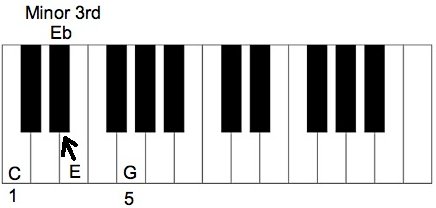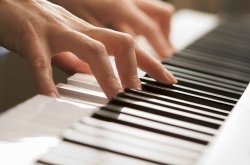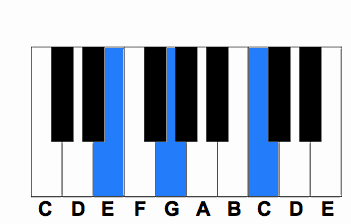Learning the E Blues Scale, like any other blues scale, can seem a little overwhelming.
When you are used to playing the more simple major scales, a blues scale can be a little more intimidating.
Let’s not let it get the best of us.
I’m going to show you an easy to use method to construct and master the this scale.
What are we waiting for? Let’s jump right in.
Notes in the E Blues Scale
The notes that make up this scale are E, G, A, Bb, B, D, and E.
There are seven notes in the scale, six different notes, and a repeated “E” note know as an octave. This octave completes the scale making an entire Blues Scale.
Take a look at the image below and you will see the notes labeled on the piano keyboard.
Make sure you take a listen to the audio file to hear this scale in action.
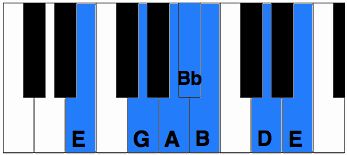
If you look carefully at the notes you will notice that they are all white keys except for one. This makes it easy when playing this scale.
Remember that you need to exclude both F and C when playing this scale.
Notation
Take a look at the image below to see the notes of this scale on the piano staff.

The only note affected in this scale is the Bb. There is one B Natural and one Bb. The first B is Flat and the second B is a Natural.
In other words: Play a B note, and the black note directly to the left of B in this scale.
How to Build The E Blues Scale
Once you learn the basics of constructing a blues scale there’s nothing to building the E scale.
There are two ways that you can successfully build this scale:
- By adjusting the E Major Scale
- Using Whole Steps and Half Steps
Let’s start by looking at the easiest of the two methods
Comparing to the E Major Scale
If you are able to build an E Major Scale, then you can easily build the E Blues.
There is a simple formula that you can apply to E Major Scale which gives you the E Blues.
First…… Let’s start by looking at the E Major Scale.
The notes in the E Major Scale are E, F#, G#, A, B, C#, D#, and E.
Take a look at the image and see the notes in the E Major Scale.
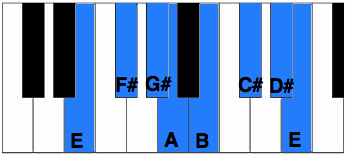
Second…… You need to adjust a few notes in the E Major Scale. To do this you need to flat the third note, fifth note, and seventh note in the E Major Scale.
Take a look at the image to see how these notes are changed to create the E Blues Scale.
Quick Tip!
Blues Scale Formula: b3, b5, b7
Whole Steps and Half Steps
Another formula that you can follow to build the E Blues Scale is by using whole steps and half steps.
This method starts by finding the tonic note of the scale. Tonic is a fancy word to describe the note in which the scale is built around or the starting note, in this case E.
Starting on E you need to follow this formula of Whole Steps and Half Steps.
Whole Step + Half Step, Whole Step, Half Step, Half Step, Whole Step + Half Step, Whole Step
See the image for clarification on how this formula woks.

Fingering
Fingering for the E Blues Scale is a little different from any other scale you may have played. But because of the large jump from E to G you need to play this scale using a special fingering.
Right Hand Fingering
Ascending
To play this scale in the right hand yo need to start with the thumb on E. Play up the scale until you reach the Bb with your ring finger.
Once there, tuck your thumb under your ring finger to play the B. Then continue up the scale ending on the E with your middle finger.
Descending
Coming back down the scale you start with the third finger on E. Play down the scale using the index finger until you reach B with your thumb.
Cross over your thumb with the ring finger to play the Bb. Then continue down the scale playing each note in the scale with the remaining fingers ending on E.
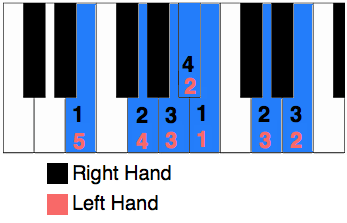
Left Hand Fingering
Ascending
To play the E blues scale with the left hand you need to start on the E with your small finger. Play up the scale with the rest of the remaining fingers until you reach B with your thumb.
You then cross over your thumb with your middle finger to play D, and end the scale playing E with the index finger.
Descending
The descending scale starts with the index finger on E. Next play D with the middle finger.
You then cross under the middle finger with thumb and play B. You then finish off the scale with the remaining four fingers ending on E.
Use the E blues Scale to get rich soulful sound. This scale is great to use when improvising on blues song in E. Make sure to memorize each note in the scale and each method used above to construct the scale.
Once you learn the method for this scale you can then apply it to other blues scales to easily build them as well.
Go From E Blues Scale Back to How To Play Scales
Back to Home Page

